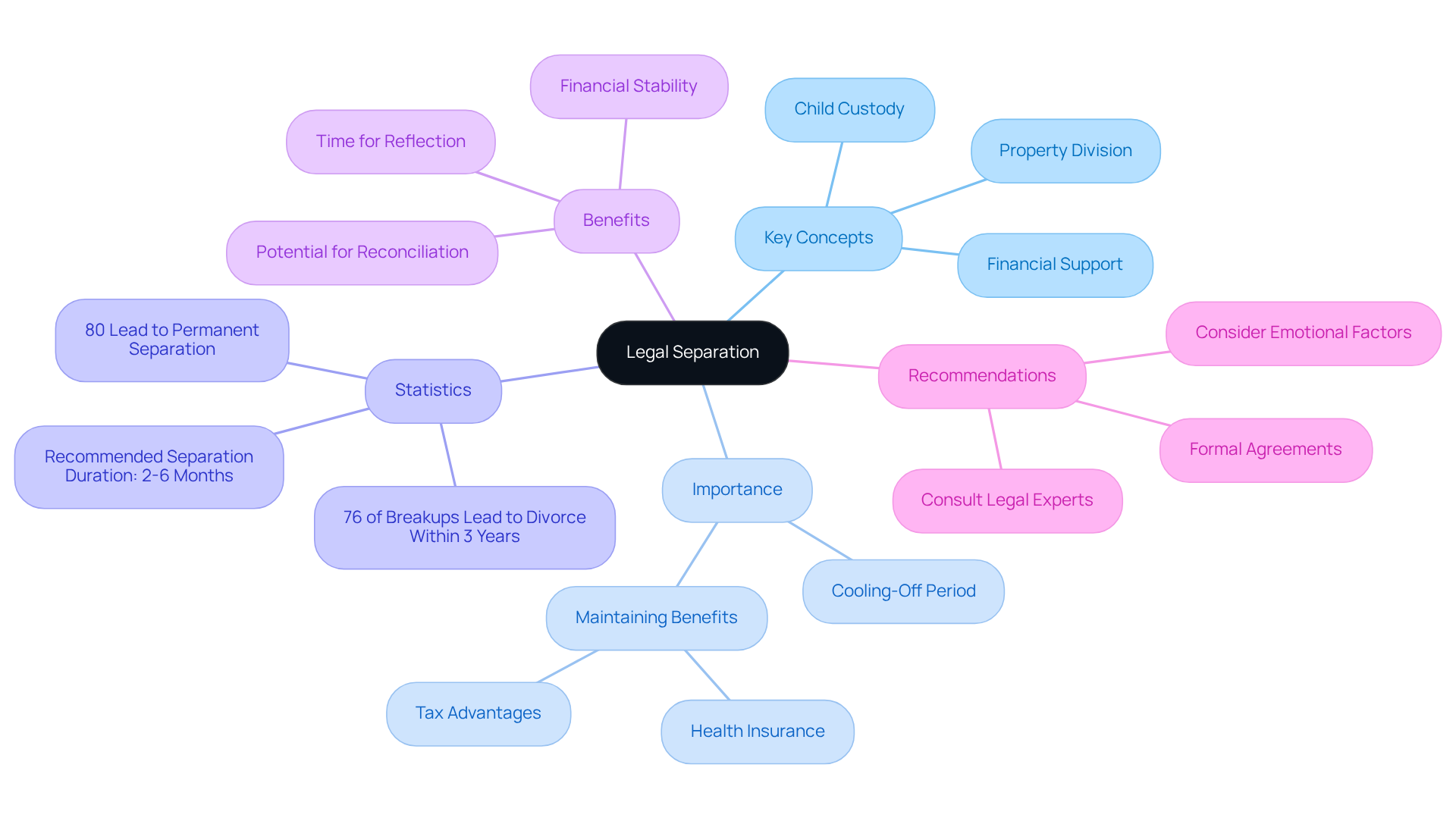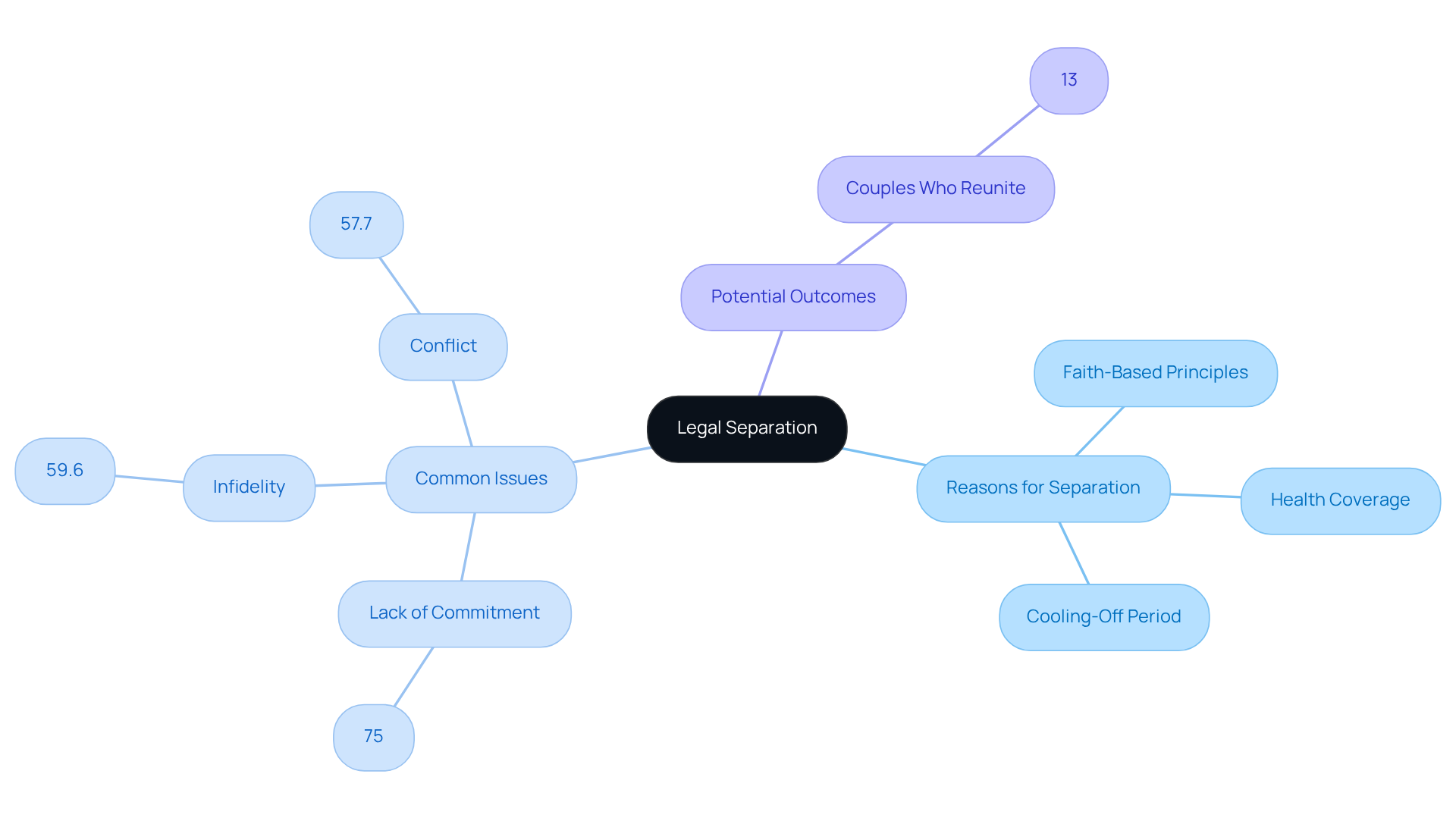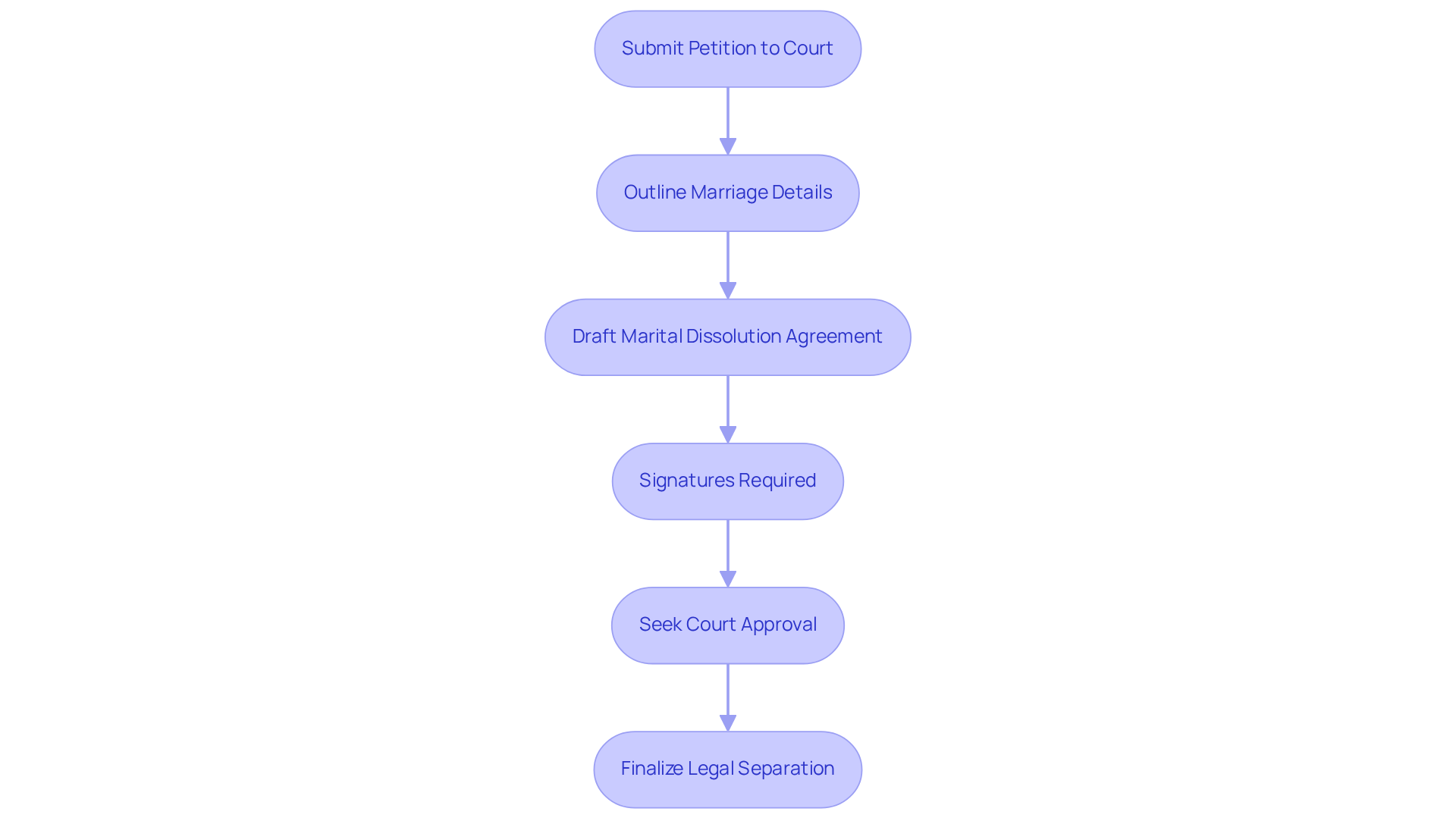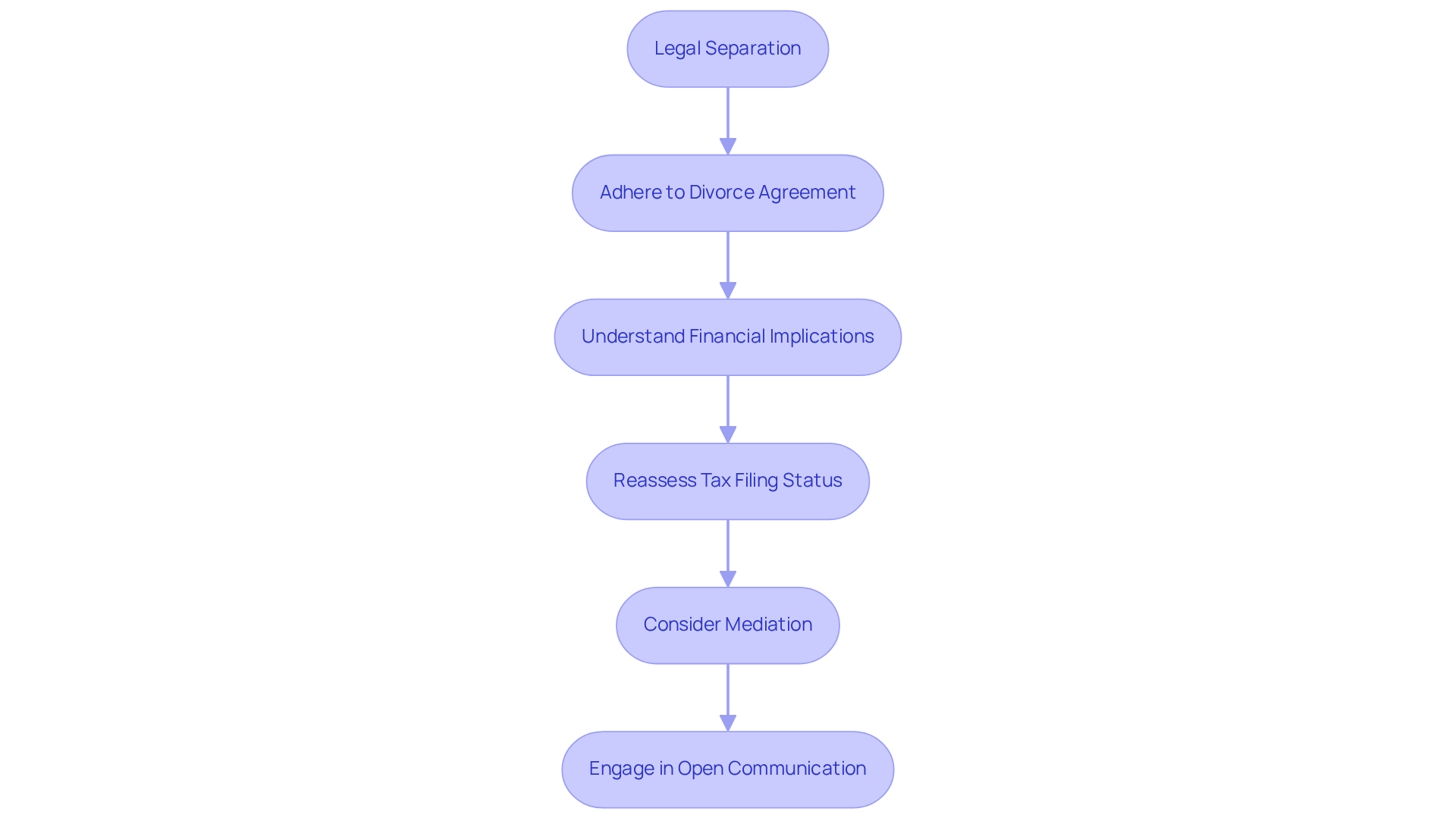
What is Considered a Legal Separation: Key Concepts Explained
Overview
Legal separation is a formal procedure that allows married partners to live independently while still maintaining their marital status. This arrangement enables them to address critical issues such as property division, financial support, and child custody. It provides a structured opportunity for couples to reflect on their relationship without fully terminating their marriage. This can lead to either reconciliation or informed decisions regarding divorce.
Have you ever felt the weight of uncertainty in your relationship? Legal separation can be a compassionate step forward. It allows you to explore your feelings and circumstances while still holding on to the possibility of reconciliation. You’re not alone in this journey; many couples find that this time apart helps them gain clarity and perspective.
Consider the benefits of this process:
- Time for reflection on your relationship.
- Opportunity to address important issues like finances and child custody.
- A chance to make informed decisions about your future together or apart.
Ultimately, legal separation can be a nurturing choice, offering a pathway to understanding and healing. If you’re feeling overwhelmed, remember that seeking support can help you navigate this challenging time. You deserve to find peace and clarity in your relationship.
Introduction
Navigating the complexities of marital relationships can be overwhelming, often leading partners to consider alternatives to divorce, such as legal separation. This arrangement allows couples to live apart while still being legally married, providing a structured opportunity to address critical issues like property division and child custody. Yet, with many separated couples eventually choosing divorce, we might wonder: is legal separation a stepping stone toward reconciliation, or simply a pause before the inevitable?
This article explores the key concepts and implications of legal separation, offering insights to help you navigate this challenging period with clarity and purpose. Together, we can reflect on the possibilities that lie ahead and find a path that aligns with your needs and emotions.
Define Legal Separation: Key Concepts and Importance
Formal dissolution is an official procedure that allows married partners to live independently while still being married. This arrangement provides a unique opportunity for partners to address important issues like property division, financial support, and child custody without fully ending their marriage. Unlike the dissolution of marriage, which permanently concludes the marital relationship, what is considered a legal separation allows the marriage's legal status to be maintained. This means partners can retain certain benefits, such as health insurance and tax advantages. For many, this option is particularly appealing as it allows time apart to reflect on the relationship without making a definitive choice.
Statistics show that around 80% of separated partners eventually separate permanently, while only about 20% find their way back to each other, often influenced by changes in perspectives or expectations. Notably, 76% of breakups lead to divorce within three years, highlighting the likelihood of divorce following a breakup. Legal separation can act as a cooling-off period, giving couples the space to thoughtfully consider their relationship dynamics. Family law specialists recommend that this period apart ideally lasts between 2 to 6 months, allowing ample time to address underlying issues.
A formal agreement can outline conditions for property division and child arrangements, ensuring both parties are clear about their responsibilities during this transitional time. Family law attorneys emphasize the benefits of formal dissolution, noting that it helps couples maintain financial stability and access to healthcare benefits, which could be lost if the marriage is fully terminated. Jerome A. Scharoff, a lawyer, wisely states, "Whether you’re leaning toward parting ways or ending a marriage, obtaining the appropriate support is essential." This arrangement can be especially helpful for those who are unsure about ending their marriage, as it presents what is considered a legal separation, which could lead to reconciliation or a more informed decision about divorce. Additionally, formal separation may provide potential tax advantages, making it even more appealing.
By understanding the complexities of divorce, including the emotional aspects and the importance of a formal agreement with court approval, partners can make decisions that align with their unique situations and future goals.

Context of Legal Separation: When and Why It Matters
Facing substantial marital difficulties can be overwhelming, especially when partners are not ready to end their marriage. Understanding what is considered a legal separation offers a structured way to address critical issues like financial obligations and child custody, all while allowing time for reflection and reassessment of the relationship. Many partners choose this path for various reasons—perhaps faith-based principles discourage divorce, the desire to maintain health coverage, or the need for a cooling-off period to evaluate emotions and possibilities.
Did you know that what is considered a legal separation can be particularly advantageous for those approaching the 10-year mark for Social Security benefits? A divorced spouse is entitled to these benefits if the marriage lasted at least 10 years. This arrangement not only clarifies each spouse's needs and priorities but can also pave the way for what is considered a legal separation. During this time, partners might rediscover their affection for one another, making it easier to reunite than navigating the complexities of remarrying after a divorce. In fact, approximately 13% of separated partners find their way back to each other, highlighting the potential for renewed connections.
Marriage counselors often emphasize that legal disengagement provides essential space for partners to tackle underlying issues, such as:
- Lack of commitment (75%)
- Infidelity (59.6%)
- Conflict (57.7%)
These are common causes of marital disruption. By setting clear boundaries and responsibilities, partners can work towards resolving conflicts and determining the future of their relationship. Dr. David Hale suggests a structured break period of 2-6 months, which can be beneficial for partners to reflect on their situation. Ultimately, formal distancing is not just a step towards dissolution; it can be a strategic move that allows partners to thoughtfully and effectively address their marital challenges.

Legal Separation Process: Agreements and Requirements
Navigating a formal split can be an emotionally challenging journey. It begins with submitting a petition to the court, which reflects the divorce procedure. Couples are encouraged to outline their marriage, including the marriage date, any children involved, and the reasons for pursuing a split. Following this, a marital dissolution agreement is crafted, detailing important conditions such as asset division, spousal assistance, and child custody provisions. This agreement requires signatures from both parties and may need court approval to be legally binding.
Engaging professional counsel is crucial during this time. It helps safeguard your rights and guides you through the complexities of the process. In California, if both parties agree to the conditions, a formal disunion can be completed within weeks. This makes it a practical choice for those seeking a structured resolution without the prolonged dissolution of marriage.
Interestingly, around fifty percent of separated partners stay apart for an entire year before deciding to end their marriage. This suggests that taking time apart can serve as a beneficial cooling-off phase. Additionally, understanding the financial implications is essential for effective planning. The typical expenses linked to divorce agreements can fluctuate, with projections ranging from $1,500 to $5,000, depending on the intricacy of the situation.
As family law experts note, having a well-drafted agreement can prevent future disputes and provide clarity on financial matters, ensuring both parties can move forward with confidence. Furthermore, acquiring a formal split does not require the obligatory six-month waiting time that a dissolution does, which can be a significant advantage for partners seeking a quicker resolution. Remember, you are not alone in this process; support is available to help you through every step.

Implications of Legal Separation: Rights, Responsibilities, and Next Steps
When partners formally separate, it’s crucial to adhere to the conditions outlined in their divorce agreement. This may include responsibilities like spousal support and child custody arrangements. While this official disunion allows partners to live independently and manage their finances separately, it's important to understand what is considered a legal separation, as they are still regarded as married under the law. This means they cannot remarry unless they file for dissolution of marriage. This legal status can significantly influence financial planning, especially concerning tax implications. Have you thought about how this might affect your filing status? Couples may need to reassess whether to file jointly or individually, which can impact their overall tax obligation.
Research indicates that attorney fees and court costs for separation can be similar to those for divorce, often ranging from $7,000 to $20,000, depending on the complexity of the situation. It's also noteworthy that about 80% of marital separations eventually lead to divorce. This highlights the importance of clear financial planning during such a transitional period. As Camila Ruiz wisely states, "The main purposes of legal separation contracts are to protect each spouse's rights and settle practical matters when living apart, which is important in understanding what is considered a legal separation."
Engaging in open communication is vital. Couples should consider mediation to address any disputes that might arise, ensuring that both parties' rights and responsibilities are clearly defined and understood. This proactive approach can help mitigate misunderstandings and facilitate a smoother transition during what can be a challenging time. Remember, you are not alone in this process; reaching out for support can make all the difference.

Conclusion
Legal separation is a vital alternative for couples navigating marital challenges. It allows partners to live apart while still being legally married. This arrangement helps address important issues like property division and child custody, and it offers a chance for reflection and possible reconciliation. By understanding what legal separation entails, couples can manage their emotions and responsibilities without the immediate pressure of divorce.
In this article, we've explored key concepts surrounding legal separation, emphasizing its importance and the factors that influence a couple's decision to pursue this path. The process involves formal agreements outlining financial obligations and responsibilities, serving as a beneficial cooling-off period. It's worth noting that a significant percentage of separated couples eventually transition to divorce, while others may find their way back to each other, highlighting the complexity of marital dynamics.
Ultimately, legal separation is not just a pause in a relationship; it’s a thoughtful strategy that allows partners to evaluate their situations. Engaging in open communication and seeking professional guidance can empower couples to make informed decisions about their futures. If you’re considering this option, understanding the implications and responsibilities involved is crucial. It sets the foundation for either a renewed commitment or a more definitive conclusion to your marital journey. How might this opportunity for reflection shape your path forward?
Frequently Asked Questions
What is legal separation?
Legal separation is a formal procedure that allows married partners to live independently while still being married. It enables them to address issues like property division, financial support, and child custody without fully dissolving their marriage.
How does legal separation differ from divorce?
Unlike divorce, which permanently ends a marital relationship, legal separation maintains the marriage's legal status. This allows partners to retain certain benefits, such as health insurance and tax advantages.
What are the benefits of legal separation?
Legal separation provides a cooling-off period for couples to reflect on their relationship, maintain financial stability, and keep access to healthcare benefits. It can also offer potential tax advantages.
What do statistics say about separated partners?
Statistics indicate that about 80% of separated partners eventually separate permanently, while around 20% reconcile. Additionally, 76% of breakups lead to divorce within three years.
How long should a legal separation last?
Family law specialists recommend that the period of legal separation ideally lasts between 2 to 6 months to allow couples ample time to address underlying issues.
What should a formal agreement during legal separation include?
A formal agreement can outline conditions for property division and child arrangements, ensuring both parties understand their responsibilities during the separation.
Why is it important to seek legal support during separation?
Obtaining appropriate legal support is essential whether partners are considering parting ways or ending a marriage, as it helps them navigate the complexities of divorce and make informed decisions.
Can legal separation lead to reconciliation?
Yes, legal separation can provide couples with the time and space to thoughtfully consider their relationship dynamics, potentially leading to reconciliation or a more informed decision about divorce.


